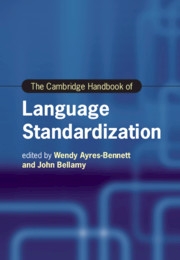Book contents
- The Cambridge Handbook of Language Standardization
- cambridge handbooks in language and linguistics
- The Cambridge Handbook of Language Standardization
- Copyright page
- Contents
- Figures
- Tables
- Contributors
- Introduction
- Part I Revisiting Models and Theories of Language Standardization
- 1 Modelling Language Standardization
- 2 Language Standardization ‘from Above’
- 3 Language Standardization in a View ‘from Below’
- 4 Social Cohesion and Emerging Standards of Hindi in a Multilingual Context
- 5 Standardization in Highly Multilingual National Contexts
- 6 Standardization of Minority Languages
- Part II Legitimacy, Authority and the Written Form
- Part III Norms, Literacy and Education
- Part IV Beyond the National
- Part V Standardization in Late Modernity
- Name Index
- Subject Index
- References
6 - Standardization of Minority Languages
Nation-State Building and Globalization
from Part I - Revisiting Models and Theories of Language Standardization
Published online by Cambridge University Press: 01 July 2021
- The Cambridge Handbook of Language Standardization
- cambridge handbooks in language and linguistics
- The Cambridge Handbook of Language Standardization
- Copyright page
- Contents
- Figures
- Tables
- Contributors
- Introduction
- Part I Revisiting Models and Theories of Language Standardization
- 1 Modelling Language Standardization
- 2 Language Standardization ‘from Above’
- 3 Language Standardization in a View ‘from Below’
- 4 Social Cohesion and Emerging Standards of Hindi in a Multilingual Context
- 5 Standardization in Highly Multilingual National Contexts
- 6 Standardization of Minority Languages
- Part II Legitimacy, Authority and the Written Form
- Part III Norms, Literacy and Education
- Part IV Beyond the National
- Part V Standardization in Late Modernity
- Name Index
- Subject Index
- References
Summary
The standardization of minority languages has little room in language policy and language planning because models of nation-state building are generally not designed to accommodate minority languages, while standardized minority languages often lead to challenges for the state. This chapter reviews how various ideologies, such as nationalism, nationism and patriotism, interact with nation-state building and globalization in shaping approaches to the standardization of minority languages. As a case study, it examines how China, adopting the Soviet model of multinational state building, technically standardized minority languages in a two-track multilingual system where standardized Chinese functioned as the main track and standardized minority languages functioned as the satellites of an eventual linguistic integration. Since the failure of this model in the 1990s, globalization has created opportunities in China through transnational institutions, such as UNESCO and ISO, and technical revolutions, such as the Internet, for bottom-up efforts at the standardization of minority languages. The case shows a trajectory from the state monopoly of the agency of standardization to the diversity of the agency among the state, local communities and the global community. This development appears to be the future of the standardization of minority languages in multilingual nation-states in an age of globalization.
Keywords
- Type
- Chapter
- Information
- The Cambridge Handbook of Language Standardization , pp. 170 - 198Publisher: Cambridge University PressPrint publication year: 2021



